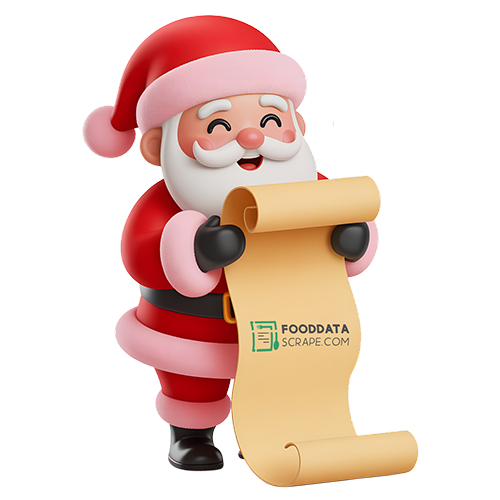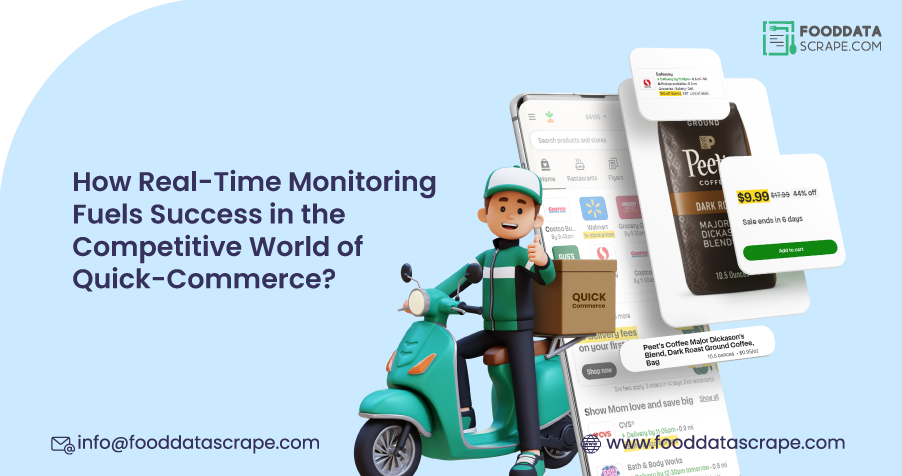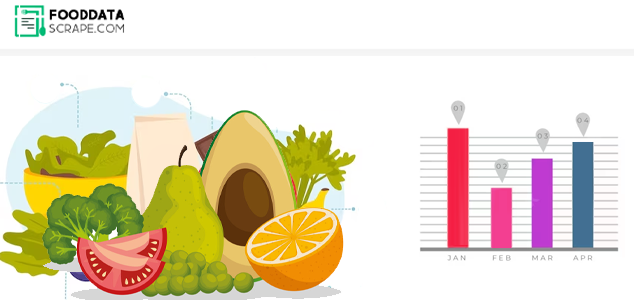Introduction
In the fast-paced world of quick commerce, with delivery times marked in minutes and customer expectations tied to cost and convenience, a competitive advantage is a never-ending sprint. Quick-commerce businesses must operate through a dynamic system of changing prices, shifting customer needs, and rapidly changing promotions. The key is Quick-Commerce Competitive Price Monitoring, allowing real-time visibility into market movement. With Real-Time Competitor Price Scraping, companies receive real-time information about competitor pricing strategies. They can respond immediately by modifying prices, creating one-time offers, or upgrading product packages.
Moreover, having access to Scrape Competitor Inventory and Pricing Data keeps companies abreast of product stock levels and demand trends. Not only does this ongoing tracking feed wiser, data-driven decisions, but also operational efficiency, customer loyalty, and top-line growth. This blog will explore how real-time intelligence transforms quick-commerce strategies and helps brands thrive in today’s fiercely competitive delivery ecosystem.
The Quick-Commerce Battlefield: Why Speed and Data Matter
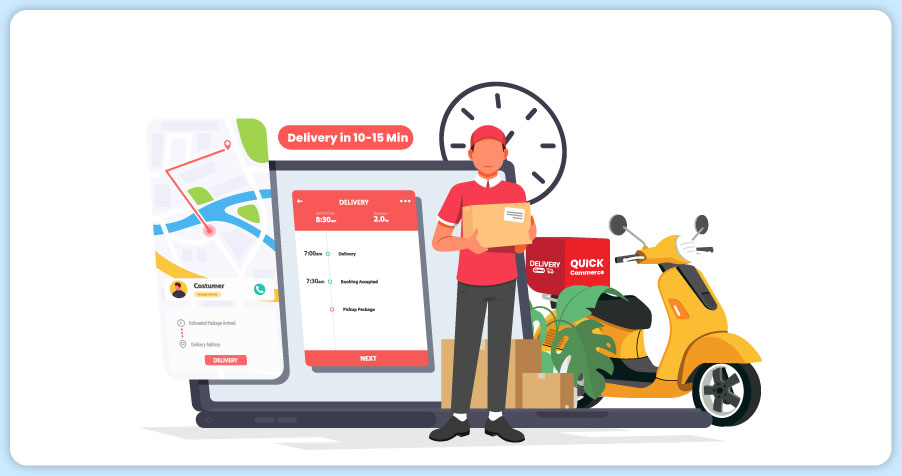
Quick-commerce, often dubbed "q-commerce," is defined by its promise of ultra-fast delivery—groceries, essentials, or meals delivered in as little as 10-15 minutes. This speed comes with immense pressure to maintain competitive pricing, ensure product availability, and offer promotions that capture customer attention. With players like DoorDash, Instacart, and regional giants crowding the market, standing out requires more than fast delivery. Real-Time Price Intelligence for Q-Commerce Platforms allows businesses to stay ahead of price fluctuations and adjust offerings in real-time to maintain a competitive edge.
The challenge is compounded by the need to monitor multiple platforms simultaneously. Prices, discounts, and stock levels fluctuate constantly, and a single misstep, such as pricing a product too high or running out of a popular item, can drive customers to competitors. Real-Time Retail Scraping API for Quick-Commerce enables businesses to continuously track these changes across various platforms, ensuring they never miss a beat.
Continuous monitoring addresses this by providing a real-time pulse on the market, enabling companies to react swiftly and strategically. Grocery App Data Scraping Services empower businesses to gather essential market data, from product availability to promotional pricing, allowing them to optimize inventory and improve customer satisfaction.
What is Continuous Monitoring in Quick-Commerce?
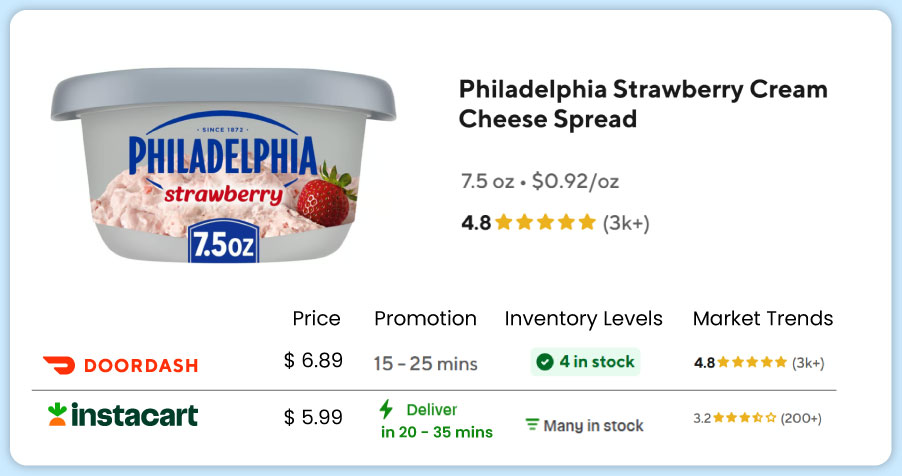
Continuous monitoring involves systematically collecting and analyzing data on competitors’ prices, promotions, inventory levels, and customer-facing activities. Unlike periodic audits, which offer market snapshots, continuous monitoring operates in real time, capturing dynamic changes as they happen. This approach leverages advanced tools, such as web scraping, APIs, and AI-driven analytics, to track:
- Competitor Pricing: Real-time updates on how rivals price products, from everyday essentials to high-demand items.
- Promotional Activities: Insights into discounts, flash sales, and loyalty programs offered by competitors.
- Inventory Levels: Provide visibility into stock availability, helping businesses anticipate supply chain disruptions or capitalize on competitors’ shortages.
- Market Trends: Broader shifts in consumer demand, seasonal preferences, or emerging product categories.
By integrating these insights into their operations, quick-commerce companies can adjust pricing, restock inventory, or launch counter-promotions with unmatched speed.
The Competitive Edge: How Continuous Monitoring Drives Success
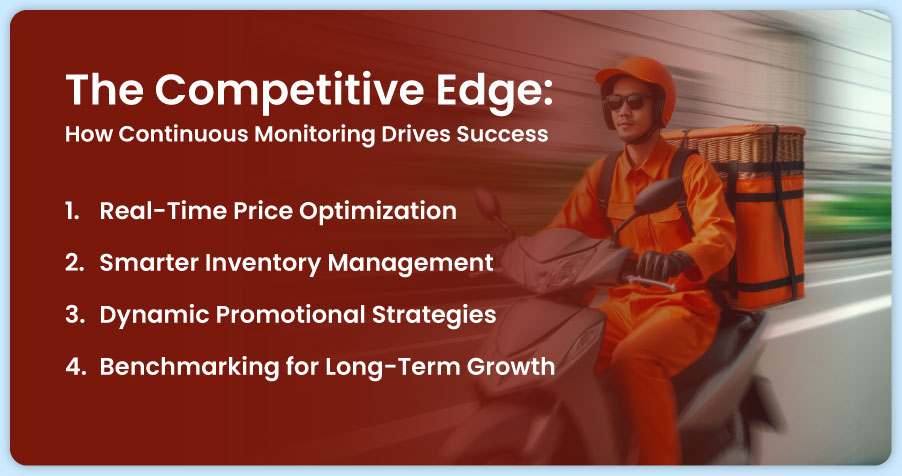
Continuous monitoring is more than a defensive tactic—it’s a strategic tool that fuels proactive decision-making. Here’s how it delivers a competitive advantage in quick-commerce:
- Real-Time Price Optimization: Pricing is a make-or-break factor in quick-commerce. Customers are price-sensitive, often comparing options across apps before placing an order. Continuous monitoring allows businesses to track competitors’ prices in real time and adjust their own to strategically maintain parity or undercut rivals. For example, if a competitor slashes the price of a popular snack during a promotional event, a quick-commerce company using continuous monitoring can detect this change instantly. They can then decide to match the price, offer a deeper discount, or bundle the item with a complementary product to retain customers. This agility ensures they remain competitive without sacrificing margins. Web Scraping Quick Commerce Data helps businesses gather up-to-date pricing information to optimize these strategies.
- Smarter Inventory Management: Stockouts are a death knell in quick-commerce. Customers who can’t find a product will switch to a competitor in seconds. Continuous monitoring provides visibility into competitors’ inventory levels, revealing opportunities to capitalize on their shortages. For instance, if a rival is low on a high-demand item like almond milk, a company can prioritize stocking it and promote its availability to attract customers. Additionally, monitoring internal inventory alongside competitors’ helps businesses optimize their supply chain. By predicting demand spikes based on market trends, companies can avoid overstocking or understocking, reducing waste and ensuring product availability. Grocery Delivery Scraping API Services are critical in gathering real-time data.
- Dynamic Promotional Strategies: Promotions are a powerful tool for driving sales, but they must be timed and targeted effectively. Continuous monitoring enables businesses to track competitors’ promotional activities, such as flash sales or loyalty discounts, and respond with counter-offers that capture market share. For example, suppose a competitor offers free delivery on orders over $20. In that case, a company can launch a limited-time promotion for free delivery on smaller orders to appeal to cost-conscious customers. This real-time adaptability ensures promotions are relevant and competitive, maximizing their impact on customer acquisition and retention. Grocery Price Dashboard helps businesses visualize these changes and make data-driven decisions for promotions.
- Benchmarking for Long-Term Growth: Beyond immediate reactions, continuous monitoring supports strategic benchmarking. By analyzing competitors’ pricing patterns, product assortments, and customer engagement tactics over time, businesses can identify gaps in their strategies and areas for innovation. For instance, if a competitor consistently outperforms in a specific product category, a company can investigate their sourcing, pricing, or marketing tactics and adapt accordingly. Benchmarking also helps businesses stay ahead of market trends. By tracking emerging product categories or shifts in consumer preferences, companies can pivot their offerings to meet evolving demands, ensuring long-term relevance. A Grocery Price Tracking Dashboard helps to track these patterns effectively and align strategies with market movements.
How We Empower Quick-Commerce Businesses?

We specialize in helping quick-commerce companies harness the power of continuous monitoring to drive growth. Our cutting-edge platform combines AI-driven analytics, real-time data collection, and actionable insights to deliver a competitive edge. Here’s how we support businesses in the quick-commerce sector:
- Price Parity Monitoring: Our tools track competitors’ prices across platforms, ensuring our clients can maintain competitive pricing without eroding margins. Automated alerts notify teams of significant price changes, enabling rapid adjustments.
- Inventory Management: We provide real-time visibility into stock levels—both internal and competitors’—helping businesses optimize their supply chains and capitalize on market opportunities.
- Competitor Benchmarking: Our platform delivers comprehensive reports on competitors’ pricing, promotions, and product strategies, empowering clients to make informed strategic decisions.
- Customizable Dashboards: Our intuitive dashboards present data in a clear, actionable format, allowing teams to focus on execution rather than data crunching.
By integrating these capabilities into their workflows, our clients achieve greater agility, efficiency, and profitability in the hyper-competitive quick-commerce landscape.
Case Study: A 10% Revenue Boost Through Continuous Monitoring
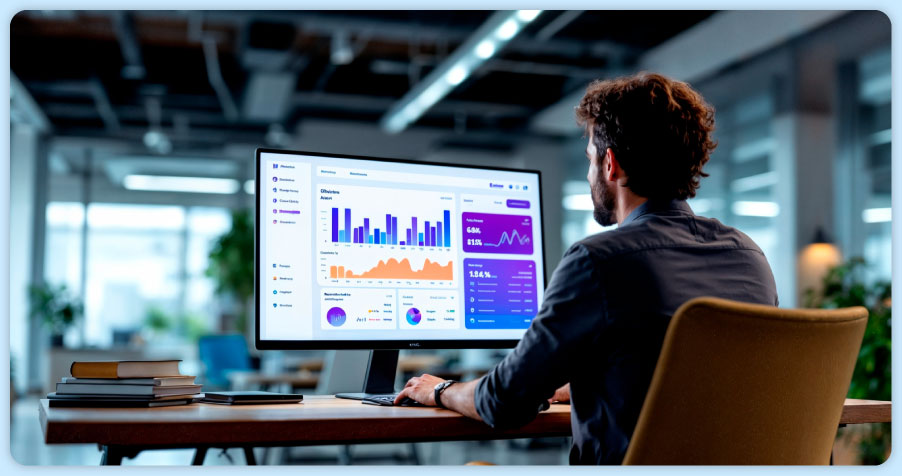
To illustrate the impact of continuous monitoring, consider the case of a mid-sized quick-commerce company operating in a primary urban market. Facing intense competition from larger players, the company struggled to maintain market share due to inconsistent pricing and frequent stockouts.
The company gained real-time insights into competitors’ pricing and inventory levels by implementing our continuous monitoring solution. Within weeks, they identified opportunities to adjust prices on high-demand items, matching or undercutting rivals without sacrificing profitability. They also used inventory data to prioritize stocking popular products, reducing stockouts by 25%.
The results were transformative. By reacting to market shifts faster than competitors, the company increased its order volume and customer retention, leading to a 10% revenue increase within three months. Additionally, their ability to launch timely promotions based on competitors’ activities boosted customer acquisition, further solidifying their market position.
Challenges and Considerations
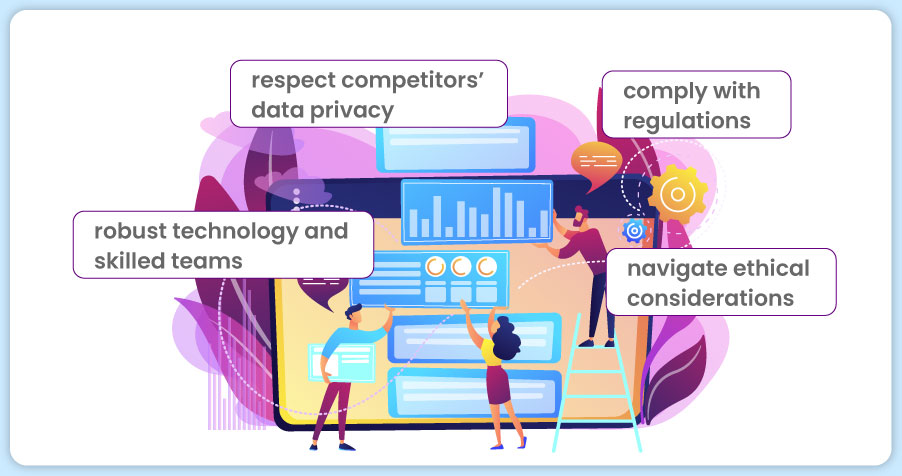
While continuous monitoring offers immense benefits, it’s not without challenges. Collecting and analyzing real-time data requires robust technology and skilled teams to interpret insights. Companies must also navigate ethical considerations, ensuring their monitoring practices comply with regulations and respect competitors’ data privacy. Partnering with a trusted provider like [Your Company Name] is critical to overcoming these hurdles. Our platform is designed to deliver compliant, high-quality data while minimizing your team's technical burden.
Stay ahead of the competition with our advanced data scraping services—contact us today to optimize your strategy and drive growth!
The Future of Quick-Commerce: Data-Driven Dominance
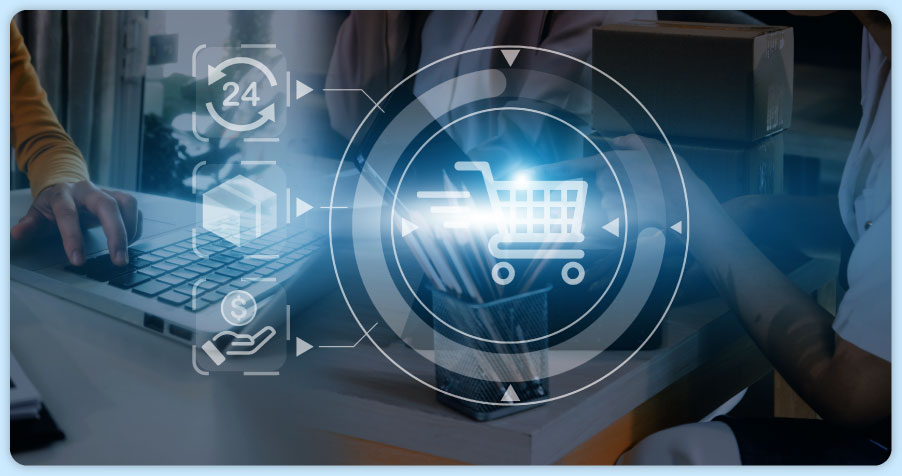
As quick-commerce evolves, continuous monitoring becomes increasingly crucial. With consumers expecting faster deliveries, lower prices, and seamless experiences, businesses that leverage real-time data will stay ahead. Continuous monitoring enables companies to track competitors' pricing, promotions, and inventory, providing the agility to respond swiftly to market shifts. Businesses can strategically outmaneuver rivals and enhance their customer offerings by optimizing operations and anticipating trends. The ability to act on dynamic data transforms quick-commerce challenges into opportunities for growth and market leadership. Companies that embrace this approach will meet consumer demands and thrive in a competitive landscape, gaining a significant edge in the ever-evolving quick-commerce industry.
How Food Data Scrape Can Help You?
- Real-Time Market Insights: Our advanced data scraping services provide real-time updates on competitor pricing, inventory levels, and promotions, allowing you to make quick, informed decisions.
- Optimized Pricing Strategies: By continuously monitoring competitor prices, we help you adjust your pricing dynamically, ensuring you remain competitive without compromising margins.
- Improved Inventory Management: Track stock levels across multiple platforms to identify opportunities for restocking or capitalizing on competitor shortages, ensuring product availability at all times.
- Timely Promotional Responses: Stay on top of competitor promotions and flash sales, enabling you to launch counter-promotions that effectively attract and retain customers.
- Strategic Market Positioning: Leverage comprehensive data analysis to identify emerging market trends and customer preferences, helping you adapt your offerings and stay ahead of the competition.
Conclusion
In the high-speed, high-stakes world of quick-commerce, continuous monitoring is not just a tool—it’s a game-changer. Providing real-time insights into pricing, inventory, and promotions empowers businesses to act with precision and speed, securing a competitive edge in a crowded market. From optimizing prices to outmaneuvering rivals with timely promotions, continuous monitoring transforms data into actionable strategies that drive revenue and growth. Grocery Pricing Data Intelligence is key in enabling businesses to adjust their pricing dynamically based on competitor and market trends. As the quick-commerce landscape becomes increasingly competitive, companies that embrace this approach will survive and thrive, delivering unmatched value to customers and stakeholders alike. Leveraging Grocery Store Datasets ensures businesses have the most up-to-date and comprehensive data to make informed decisions at every turn.
Are you in need of high-class scraping services? Food Data Scrape should be your first point of call. We are undoubtedly the best in Food Data Aggregator and Mobile Grocery App Scraping service and we render impeccable data insights and analytics for strategic decision-making. With a legacy of excellence as our backbone, we help companies become data-driven, fueling their development. Please take advantage of our tailored solutions that will add value to your business. Contact us today to unlock the value of your data.

